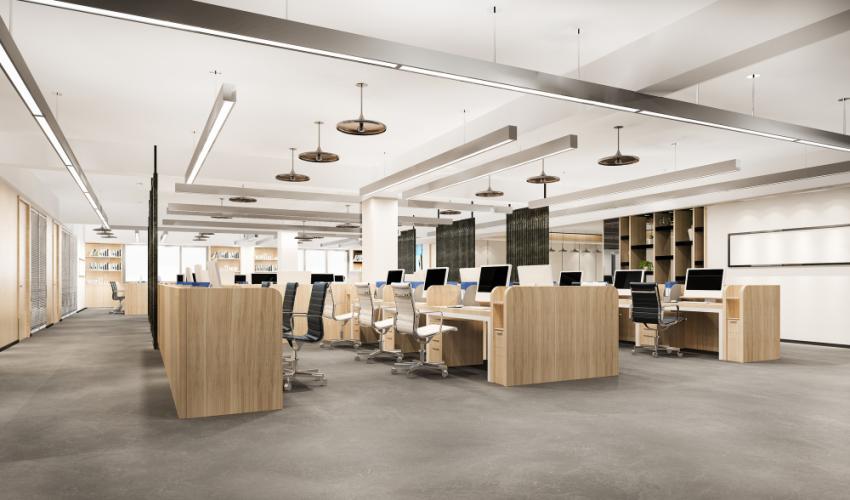
Have you ever walked into an office that feels cluttered and cramped, making it tough to stay focused? Or perhaps you’ve tried rearranging desks many times, only to find that productivity still falls flat? Designing an efficient office can feel like a maze, especially if you’re trying to balance employee wellbeing, team collaboration, and growth opportunities. But don’t worry there’s a straightforward approach to creating a workspace that ticks all the boxes.
In this blog post, we’ll break down the key steps and considerations for shaping a productive, welcoming environment. We’ll explore how office fitouts in Craigieburn can transform dull work areas into vibrant hubs that encourage greater creativity and effectiveness. From lighting and furniture choices to the smartest office technology, we’ll walk through every essential component of building an office you’ll be proud of.
By the time you reach the end, you’ll know exactly what to prioritise when planning your next fitout, how to tackle common mistakes, and how best to maintain a fresh, functional setup for years to come. Ready to delve into this topic? Let’s begin by looking at why an efficient office really matters and how it can reshape your entire working experience.
Introduction: Why an Efficient Office Space Matters
The Impact on Employee Wellbeing and Productivity
A well-structured work environment has a huge effect on employee morale and output. When people have enough space to move around and a clean, organised desk to work at, they’re more likely to feel calm and focused. Plus, a thoughtful layout can help prevent common problems like eye strain, back pain, and stress factors that often hinder day-to-day tasks.
What’s more, an efficient office space encourages teamwork. When colleagues can easily collaborate, ideas flow, and solutions come faster. This seamless communication helps boost team spirit and ensures that projects progress without getting bogged down in confusion. Ultimately, when your team feels energised rather than drained, you’ll notice a marked uplift in overall productivity.
The Role of Office Fitouts in Craigieburn
When it comes to office fitouts in Craigieburn, it’s crucial to consider local regulations, budget constraints, and the availability of support services. Craigieburn’s growing business landscape means there are plenty of solutions for businesses seeking a professional, flexible design. Working with seasoned fitout specialists gives you access to a wealth of insight on everything from ergonomics to sustainable materials.
Whether you’re relocating to a new space or giving your current office a makeover, partnering with local experts helps you tailor your layout to your specific goals. In the end, you’ll enjoy an environment that looks good, aligns with your brand, and improves effectiveness across the board.
Key Elements of an Efficient Office Design
Space Planning and Layout
Good space planning acknowledges how people naturally move around an office. Hallways should be wide enough to minimise congestion, and shared areas need to be easily accessible. Likewise, consider dividing the floor area into zones dedicated to various tasks, such as meeting rooms, private offices, and communal lounges. This arrangement ensures everyone has a designated place to work without stepping on each other’s toes.
Natural Light and Lighting Solutions
Lighting can make or break your ability to concentrate. It’s vital to maximise natural illumination through well-placed windows. At the same time, desk and overhead lighting should feature energy-efficient bulbs, adjustable brightness, and minimal glare. Proper lighting not only helps reduce eye fatigue but also contributes to a more welcoming, uplifting atmosphere.
Ergonomic Furniture Choices
Ergonomics is key. Chairs with lumbar support, adjustable armrests, and sturdy desks at the correct height drastically reduce sore backs and neck strains. Look for furniture that’s easy to move around this can help you rearrange the layout swiftly if team needs shift. Whether you’re adding standing desks, supportive seating, or keyboard trays, keep comfort and posture top of mind.
Acoustics and Sound Management
Noise pollution negatively affects focus, so it’s crucial to incorporate sound management strategies early on. Acoustic partitions or sound-absorbing panels can create quieter pockets for deep work. Carpets or specialised flooring can help dampen echoes. By blending these features, you’ll strike a balance that encourages collaboration while allowing individuals to concentrate when necessary.
Storage and Organisation
Clutter can derail productivity. Therefore, plan for enough storage solutions—like tall cabinets, shelving units, or hidden compartments to keep everything tidy. Encourage digital archiving wherever feasible, which reduces physical paperwork and frees up valuable floor space. Drawer organisers and designated filing zones also reduce wasted time hunting for documents, letting your team focus on higher-level tasks.
Branding and Aesthetics
Your environment should reflect who you are as a company. Whether you prefer a sleek, minimalist look or splashes of colour, consider incorporating brand logos, typography, and a consistent colour palette. These elements create unity and can make a powerful first impression on visitors. By aligning the décor with your mission, you show staff and clients alike that you take your brand identity seriously.
Step-by-Step Guide to Creating an Efficient Office Space
Assessing Your Current Office Setup
Start by reviewing your existing workspace. Make a list of what works well—like easy-to-access meeting rooms or up-to-date tech and what doesn’t. Seek input from employees about daily pain points. This process helps you pinpoint your priorities and avoid the pitfalls of simply replicating old layouts in a new setting.
Setting Clear Goals and Objectives
Next, define how you want your revamped space to function. Are you aiming for more collaborative zones, better acoustic control, or a stylish waiting area? Having clear objectives shapes your decisions around layout, furniture, and technology. When everyone understands these goals, it’s easier to keep the project on track and measure success once the work is complete.
Creating a Realistic Budget
Budgeting is absolutely key. Break down your costs into categories, such as construction, furniture, lighting, and extras. Keep a buffer for unexpected items that might crop up—like additional electrical work or changing needs mid-project. Having a transparent view of your finances keeps your project under control and helps prevent unpleasant surprises down the line.
Collaborating with Office Fitout Professionals in Craigieburn
Local professionals bring expert knowledge to the table. They understand Craigieburn’s regulations, supply chains, and typical workplace practices. Working closely with them ensures a quicker turnaround and a design tailored to the community’s standards and expectations. Plus, these pros can offer ideas you may not have considered, from eco-friendly materials to cutting-edge technology solutions.
Incorporating Sustainable and Eco-Friendly Solutions
Green design isn’t just about ticking environmental boxes it often saves money in the long run. By choosing energy-efficient appliances, LED lighting, and sustainable building materials, you keep utility bills lower while creating a healthier space. Employees increasingly value socially responsible workplaces, too, which can boost satisfaction and your company’s reputation.
Managing the Construction and Installation Process
Regular check-ins with your project team help you track progress and tackle issues immediately. Keep communication lines open so everyone understands deadlines and changes. If possible, schedule noisy or disruptive tasks outside peak working hours to reduce daily disruptions. This careful coordination leads to a smoother experience and happier staff throughout the project.
Final Checks and Post-Fitout Maintenance
Once construction wraps up, walk through the space with your fitout team to confirm everything aligns with your original plan. Check the quality of finishes, test any new tech, and gather team feedback on comfort and usability. Don’t forget ongoing maintenance—regular inspections, cleaning routines, and timely repairs help your office stay efficient in the long term.
Maximising Productivity with Smart Office Technology
Automation and Collaboration Tools
In today’s interconnected world, automation tools can handle repetitive tasks, freeing up employees for higher-level work. Whether it’s scheduling software for meeting rooms or project management apps that track tasks in real time, these platforms boost transparency and coordination. The result is a more streamlined workflow where everyone knows exactly what’s happening and when.
Integrating Security and Access Systems
High-tech security measures are particularly valuable in offices handling sensitive data. From biometric entry points to smart locks that grant or revoke access instantly, these features ensure peace of mind for both management and staff. Make sure that any security system you introduce respects individual privacy. Striking the right balance between protection and autonomy encourages trust and a more confident workforce.
Future-Proofing Your Office Technology
Technology is always changing, so planning for future growth can save you headaches later on. Install flexible cabling and consider modular setups that allow you to swap out outdated hardware easily. You might also embrace cloud-based solutions or subscription-based software that updates regularly without requiring a total system overhaul. This approach keeps your office environment ready to adapt as your organisation grows.
Maintaining Efficiency and Adaptability Over Time
Regular Workplace Audits and Adjustments
Even the most carefully planned office design can lose its edge over time. Workflows shift, teams expand, and technology advances. Conduct periodic workplace audits to see if your space still meets everyone’s needs. Take note of any congestion points or underused corners, and be prepared to modify your layout to maintain peak effectiveness.
Staff Feedback and Continuous Improvement
After all, your employees are on the ground every day. Encourage open dialogue by setting up suggestion boxes or quick survey forms. Act on the feedback where possible—whether it’s adding extra lighting, creating a quieter lounge, or implementing new collaboration tools. This approach not only boosts morale but also strengthens your office design as a whole.
Planning for Growth and Expansion
If your business is thriving, you’ll eventually outgrow your current space. Rather than waiting until things feel cramped, start planning early. Identify areas that can be converted into new meeting zones or extra workstations. In some cases, you might consider reconfiguring your existing layout or even relocating. Keeping an eye on future expansion ensures you’re never caught unprepared.
Conclusion
Summing up, an efficient office isn’t just about stylish furniture and fancy décor of office fitouts. It’s about creating a well-thought-out environment that meets your team’s practical needs while also reflecting your brand identity. By setting clear goals, collaborating with capable professionals, and incorporating sustainable touches, you can transform your workspace into a hub of high productivity and positive energy.



